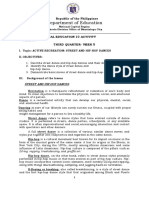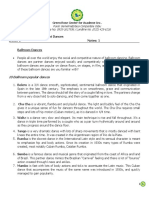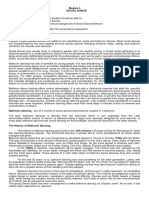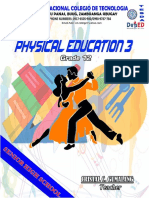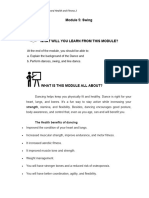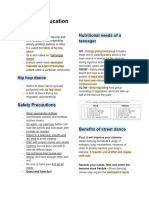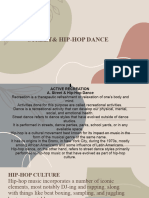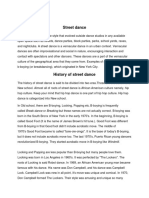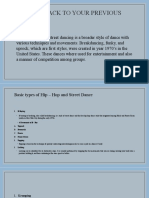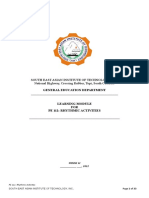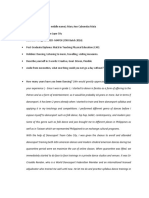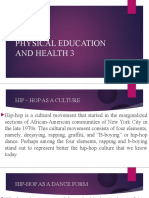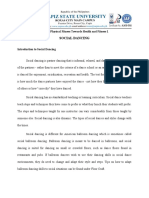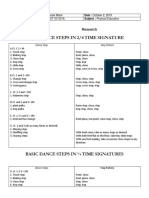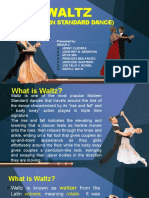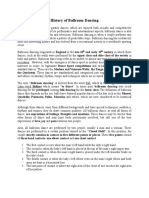Pe9 Q2 Module1 V3
Uploaded by
aireshane.parconPe9 Q2 Module1 V3
Uploaded by
aireshane.parcon9
Department of Education
National Capital Region
SCHOOLS DIVISION OFFICE
MARIKINA CITY
Music, Arts, Physical Education, and Health
PHYSICAL EDUCATION
Second Quarter – Module 1:
Background and Nature of
Social Dances
Writer: Arvin Lark P. Santiago
Cover Illustrator: John Orville S. Munar
City of Good Character 0
DISCIPLINE • GOOD TASTE • EXCELLENCE
What I Need to Know
This module suggests thoughtful choices about ways to bring a sense of normality
and joy to our life that we can do at home during this pandemic. Let us fight the
present crisis of the COVID19 pandemic with the groove of our body through
artistic body movement. People from different places enjoy dancing such as in
schools, social venues, community halls, and in the “new normal” through social
media vlogs and Tiktok. Dancing has become a popular way to be active and a
healthy exercise program. With the present situation of pandemic COVID 19,
moving your body with the rhythm of the music is not a hindrance to stay fit and
active. So be ready to groove your moves exploring the different ballroom dances,
social dances and dance mixers.
The module contains:
● Lesson 1 – Background and Nature of Different Social Dances
After going through this module, you are expected to:
1. involve oneself in community service through dance activities in the
community; PE9PF-IIg-h-41
2. describe the nature and background of the dance;
3. appreciate and analyze the benefits of ballroom dance into one’s life;
4. differentiate and classify the characteristics of different styles of ballroom
dance.
What I Know
PRE-TEST
The result of this pre-test will check your prior knowledge, understanding and
skills on this module. Read and understand each question carefully and choose
the best answer in the word pool. Write the letter of the answer on a separate sheet
of paper.
A. Quickstep B. Foxtrot C. Tango D. Waltz
E. Swing F. Paso Doble G. Samba
H. Rumba I. Jive J. Cha Cha Cha
1. A fun and cheeky Cuban dance with emphasis on quick, concise foot and
leg actions, named because of the “triple shuffle” steps.
2. An American dance that evolved from a dance called the Jitterbug by
removing the lifts and acrobatic elements.
City of Good Character 1
DISCIPLINE • GOOD TASTE • EXCELLENCE
3. Known to be the most romantic and sensual of all Latin ballroom dance,
and was originally applied specifically to the dancing style with lascivious
movement of the hip.
4. The most popular of all Brazilian ballroom dance which involves much
knee action with the dancers’ bodies resembling a swinging pendulum as
they sway and turn.
5. It is popularly known as the man’s dance, portraying the story of the
matador with the girl being the cape where the matador is to wield his
cape according to the anger and intensity of the roaring boar.
6. The dance originated from the lindy hop and its main characteristic is
the “triple steps” and “rock steps” used throughout the moves.
7. Originated in Austria known as one of the smoothest ballroom dances
and the first dance to use closed dance position.
8. One of the most fascinating of all ballroom dance which originated in the
lower class of Buenos Aires especially in the Barrio de Las Ranas.
9. It is known as the first truly American ballroom dance, and was named
after Harry Fox.
10. It consists of extremely quick stepping, syncopated feet rhythms, and
runs of quick steps.
What’s In
Review
In our 1st quarter lesson in Physical Education, you have learned basic Basketball
Officiating. Below are some situations that usually occur in a Basketball Game. As
an official, you are required to make a decision. Which among the following from
the choices is the BEST call? Now, refresh your mind by writing the letter of your
answer on a separate sheet of paper.
1. Thirdy Ravena shoots a free throw that hits the front of the rim, then
bounces up and hits the top of the backboard, then it falls down and goes
in without hitting anyone else.
_____ a. The basket counts since it did not travel behind the backboard.
_____ b. No basket since the top of the backboard is out of bounds.
2. Ricci Rivero is taking the ball out under his own basket. His teammate Kobe
Paras is 6’5” tall and standing right in the middle of the lane and does not
move. Ricci waits a full 4 seconds and lobs it to Kobe who makes 2 dribbles
to the basket and scores an easy lay-up.
_____ a. No call
_____ b. A 3 second violation should be called.
3. James Yap while on the court travels with the ball. What should the referee
do?
_____ a. Whistle first, raise the arm with an open hand and give the traveling
sign.
_____ b. Just blow the whistle. Everyone knows what the call is.
City of Good Character 2
DISCIPLINE • GOOD TASTE • EXCELLENCE
Module Background and Nature of
1 Different Social Dances
The world of Social Dances is truly an interesting place to be in. Whatever type of
dance you can perform, it can easily captivate the audience. But is there a way to
learn social dances at home? Good thing, there are ways on how to properly go
about this. Do not worry if you have no idea where to start as I guide you through
your home learning.
Are you getting excited? Then keep on reading!
What’s New
ACTIVITY: Thinking Map
The following are terms associated with the lesson:
A. Social Dancing
B. Ballroom Dancing
C. Dancesport
Your task is to create your own thinking map as shown in the example below.
Write the term you selected at the center. You can draw and add as many lines as
the connections you can give about the term outside the circle. Write words that
describe your experience, description, or anything you can say about the term you
chose and wrote inside the circle. Organize your thoughts and connect the words
you came up with to describe the term you have selected.
Congratulations! You’ve done the preliminary activities successfully on
your own. I think you are more than ready for the next stage!
City of Good Character 3
DISCIPLINE • GOOD TASTE • EXCELLENCE
What is It
Nature and Background
Social dances are intended primarily to get to know other people in attendance to
a certain social function. They are usually performed in pairs, male and female,
but may also be performed in groups like Line Dance and Social Dance Mixers.
The term “ballroom” in Ballroom Dances derived from the word “ball” which
originates from the Latin word “ballare” which means to dance. Ballroom dances
are classified into two major classifications namely the Latin American Dances and
the Modern Standard Dances. Latin American Dances include the salsa, mambo,
merengue, swing, cha-cha-cha, rumba, samba, jive, boogie, and paso doble. They
are called Latin American dances because most of them are from Latin-American
countries. While the Modern Standard Dances include the slow waltz, tango,
Viennese waltz, foxtrot and quickstep.
Latin dances distinguish themselves by the costumes worn by performers. They
are somewhat revealing, tight-fitting, sexy yet sophisticated in nature. They are
also distinguished by the nature of the movements. They are freer and can be
performed in close or open hold positions. Modern Standard dances on the other
hand, wear formal, ankle-length gowns for females and coat-and-tie for males.
Most of the time, movements in these are restricted to close ballroom positions
with partners.
Social dances and Ballroom dances are different from Dancesport because the
latter is freer in nature and are primarily intended to widen one’s social horizon,
for recreation; and fitness. The former is performed in competitions and is referred
to as competitive ballroom dancing. The required athleticism has established rules
of different levels of difficulty.
Latin American Dances
1. Cha Cha Cha
✔ A fun and cheeky Cuban dance with emphasis on quick, concise foot and
leg actions, based on the Rumba. This dance evolved from the Mambo
dance and has its origins in the religious ritual dances of West Africa
✔ Named because of the “triple shuffle” or “Chasse” that is apparent in most
basic steps.
City of Good Character 4
DISCIPLINE • GOOD TASTE • EXCELLENCE
2. Jive
✔ An American dance that evolved from a dance called the Jitterbug by
removing the lifts and acrobatic elements.
✔ Dancers use a more bouncy type movement using the balls of the feet
and lot of kicks
✔ A very fast, energy-consuming dance known by many names,
sometimes called Swing, Boogie, Lindy hop, or Charleston, although it is
a completely different dance.
3. Rumba
✔ The "Grandfather of the Latin dances" known to be the most romantic
and sensual of all Latin ballroom dance.
✔ The name Rumba was originally applied specifically to the dancing style
with lascivious movement of the hip, bosom and other flexible parts.
4. Samba
✔ The most popular of all Brazilian ballroom dances.
✔ It is lively and vigorous and the feet are constantly leaving the floor.
✔ It is literally a bouncing step which involves much knee action with the
dancers’ bodies resembling a swinging pendulum as they sway and
turn.
5. Paso Doble
✔ One of the liveliest ballroom dances, modeled after the sound, drama,
and movement of the Spanish bullfight in the 1930’s.
✔ It is popularly known as the man’s dance, portraying the story of the
matador with the girl being the cape where the matador is to wield his
cape according to the anger and intensity of the roaring boar.
6. Swing
✔ A lively style of American social dance, favorite among social dancers of
all ages in which a dancer often lifts, spins and flips the partner.
✔ The dance originated from the lindy hop and its main characteristic is
the “triple steps” and “rock steps” used throughout the moves.
7. Merengue
✔ A fast Latin dance that never slows down originated in the Dominican
Republic.
✔ It’s very easy to learn and often refers to this dance as the “marching with
style”.
8. Salsa
✔ This dance originated in Cuba and is also similar to Mambo because both
have a pattern of six steps danced over eight counts of music.
✔ Both dances share many of the same basic movements. Mambo moves
generally forward and backward, while Salsa has more side to side steps.
City of Good Character 5
DISCIPLINE • GOOD TASTE • EXCELLENCE
9. Mambo
✔ The dance originated in Cuba, and is one of the most sensual and
emotional Latin American ballroom dances.
✔ Swaying hip movements, facial expressions, arm movements and holds
add to the sensuality of the dance.
Modern Standard Dances
1. Waltz
Originated in Austria known as one of the smoothest ballroom dances
and the first dance to use closed dance position.
The dance is so graceful and elegant marked by progressive, long, flowing
movements, continuous turns, and "rise and fall.
Dancers of Waltz appear to glide around the floor with almost no effort.
2. Tango
✔ One of the most fascinating of all ballroom dance which originated in the
lower class of Buenos Aires especially in the Barrio de Las Ranas.
✔ This sensual ballroom dance originated in Argentina in the early
twentieth century and was first known as baile con corte- the dance with
a stop.
✔ It is characterized by sudden changes of direction and its many flaring
and dipping steps.
3. Foxtrot
✔ An American smooth dance evolving from trotting dance in 1913 in
which dancers make long, flowing movements across the floor.
✔ It is known as the first truly American ballroom dance, and was named
after Harry Fox.
4. Quickstep
✔ Originated in America
✔ A quick version of the Foxtrot
✔ It consists of extremely quick stepping, syncopated feet rhythms, and
runs of quick steps.
✔ The dance is exciting to watch, but among the most difficult of all is
ballroom dance.
City of Good Character 6
DISCIPLINE • GOOD TASTE • EXCELLENCE
BASIC BALLROOM DANCE POSITIONS
The following basic dance positions determine how you relate to your partner
during the dance. The man stands on the left side, and the woman is always on
the right side in all these positions.
Wrap Position Shoulder- Challenge- Swing Out Facing
Waist Position Position Position Position
Conversation Inside Hand Escort Varsovienne Reverse
Joined Position Varsovienne
Right Parallel Left Parallel Reverse Open Semi-Open Open Position
Swing Side Car Position Position
Closed Pigeon Wing Butterfly Promenade Back Cross
Position Position Position Position Position
Photo credits: Margaux Jovellano and Mac Arthur Abaya of Marisci Dance Company
Ballroom and Social Dancing Benefits
1. Health
Ballroom and Social Dances can decrease blood pressure and cholesterol,
improve cardiovascular health, strengthen weight-bearing bones, help
prevent or slow bone loss related to osteoporosis, lower the risks of obesity,
and promote increased lung capacity.
City of Good Character 7
DISCIPLINE • GOOD TASTE • EXCELLENCE
2. Physical
Ballroom and Social dancing is a low-impact aerobic activity that burns fat
and can boost your metabolism. It also reduce stress, improve balance and
mobility, increase flexibility and coordination, increased strength & stamina,
and good for muscle toning
3. Mental
Ballroom and Social dancing enhances memory, alertness, awareness,
focus, and concentration.
4. Social
Ballroom and Social dancing can improve confidence level, improve attitude,
increase sense of well-being & more positive outlook, & build social
connections.
SOCIAL DANCE ETIQUETTE
Social dancing requires close personal contact between partners which requires
some level of trust and respect. The dance etiquette helps us build that trust and
respect by giving us a general framework to work from. It allows us to have mutual
understanding of behavior at events that encourage respect.
1. ASKING FOR A DANCE?
In a social dance situation it is customary to dance with different people.
So, when you ask someone to dance, be sure to make eye contact with
your prospective dance partner, offer your hand and ask directly, “Would
you like to dance?” If the person says yes, offer your hand and walk with
him or her onto the dance floor. This helps your partner feel supported
and at ease.
2. LEARN TO SAY NO
If you are really tired when someone asks you to dance, say that you are
taking a rest and would be happy to dance later. Then be sure to keep
this commitment. Or if you just come to the dance to watch and someone
asks you to dance, it is fine to say, “Thank you, but I’m just watching
tonight.”
3. GOOD HYGIENE
Social dancing is an intimate activity in that it requires physical
closeness. Good hygiene before and during a dance shows respect and
consideration for the other dancers.
4. PARTNER’S ABILITY
Complement rather than giving corrections to your partner’s ability.
Unless someone asks you to make a correction, never give criticisms of
your dance partner’s abilities. Know that your dance partner is doing the
best that he or she can do.
5. SOCIALIZE
Get along with each other as you rotate partners. Say hello and introduce
yourself to each new partner, after all that is the true essence of social
dance.
In the next phase, you will be given more activities to enhance and deepen
your understanding of the lesson.
City of Good Character 8
DISCIPLINE • GOOD TASTE • EXCELLENCE
What’s More
ACTIVITY 1: Search for Mr. and Ms. Q and A of Fitness
In this activity, you will be provided with an opportunity to voice out your opinions,
ideas and plans as regards your participation to community fitness programs with
social dances as your medium through a Q and A. Write your answer on each
question on a separate sheet of paper
Questions
1. In this time of pandemic, what role do social dances and dance mixers play
in this world dominated by technological advancements?
2. How can social dancing and dance mixers contribute to fitness and
community building?
3. How can you be an agent of fitness in your community?
4. If you were an ambassador of fitness what programs would you initiate in
your community?
ACTIVITY 2: Table Completion
Classify the category of each dance in the word pool and write its place of origin.
Copy and complete the table on a separate sheet of paper
Cha Cha Cha Rumba Foxtrot Samba Tango
Paso Doble Jive Swing Quickstep
Merengue Salsa Mambo Waltz
Latin American Modern Standard
1. 1.
2. 2.
3. 3.
4. 4.
5.
6.
7.
8.
9.
City of Good Character 9
DISCIPLINE • GOOD TASTE • EXCELLENCE
ACTIVITY 3: Picture Identification
Identify the type of ballroom dance position of each picture. Write your answer on
a separate sheet of paper
1. __________ 2. __________ 3. __________
4. __________ 5. __________
You're nearly accomplished with this module!
What I Have Learned
In this activity, your knowledge will be assessed through the given completion
statements below. You are encouraged to come up with your own idea to complete
the given statements. Write your completed paragraph on a separate sheet of
paper.
Social dances commonly known as _________________________. Social
dances are ________________________________________________________
_______________________________________. They are classified into two
groups, _____________________ and _________________________. The two
groups differ in terms of
_____________________________________________________________________
____________________________________________________________________.
CONGRATULATIONS!
In the next phase, you will be challenged to apply things you learned
about the lesson into another context. Your understanding of the lesson
will be measured by your ability to provide evidence of your learning.
City of Good Character 10
DISCIPLINE • GOOD TASTE • EXCELLENCE
What I Can Do
Activity: Step Up
Write a reflection answering the guide questions from the stairs of success
illustrated below. Write your reflection on a separate sheet of paper
Assessment
POST-TEST
Direction: Place the letter T before the number if you think the statement is TRUE.
Place an F if FALSE. Write your answers on a separate sheet of paper.
1. Cha Cha Cha is a fun and cheeky Cuban dance with emphasis on quick,
concise foot and leg actions, named because of the “triple shuffle” steps.
2. Rumba is an American dance that evolved from a dance called the
Jitterbug by removing the lifts and acrobatic elements.
3. Jive is known to be the most romantic and sensual of all Latin ballroom
dance, and was originally applied specifically to the dancing style with
lascivious movement of the hip.
4. The most popular Brazilian ballroom dance which involves much knee
action with the dancers’ bodies resembling a swinging pendulum as they
sway and turn is called Samba.
5. Swing is popularly known as the man’s dance, portraying the story of the
matador with the girl being the cape where the matador is to wield his
cape according to the anger and intensity of the roaring boar.
City of Good Character 11
DISCIPLINE • GOOD TASTE • EXCELLENCE
6. Paso Doble originated from the lindy hop and its main characteristic is
the “triple steps” and “rock steps” used throughout the moves.
7. Waltz originated in Austria and is known as one of the smoothest
ballroom dances and the first dance to use closed dance position.
8. One of the most fascinating of all ballroom dances which originated in
the lower class of Buenos Aires especially in the Barrio de Las Ranas is
Tango.
9. Foxtrot is known as the first truly American ballroom dance named after
Harry Fox.
10. Quickstep Dance consisted of extremely quick stepping, syncopated feet
rhythms, and runs of quick steps.
Additional Activities
Activity: Integrating Weight Management and Fitness to Social Dancing
In this activity, I want you to integrate social dancing, discipline, culture, and
sense of community to fitness by coming up with an essay that explains your
interpretation on the hierarchical relationship of the elements indicated in the
diagram.
Rubric for assessment:
Point Scale Comprehensiveness Organization of Ideas
Advanced All details included in the Unity, coherence, and
5 triangle are provided and technical correctness are
explained excellently exhibited.
Proficient 1 detail in the triangle is Unity and satisfactory
4 missed but others are coherence together with
provided and explained very technical correctness are
satisfactorily exhibited.
Approaching 2 details are missed but the Unity, improving coherence
Proficiency others are provided and and minimal technical
3 explained satisfactorily errors are exhibited.
Developing 3 or more details are missed Improving unity, improving
2 but the others are provided coherence and many
and explained satisfactorily technical errors.
City of Good Character 12
DISCIPLINE • GOOD TASTE • EXCELLENCE
Answer Key
References
Books
1. Department of Education, Music, Arts, Physical Education and Health 9 Learner’s Material. First
Edition, 2017
WEBSITES
1. https://www.worlddancesport.org/About/Dance_Styles
2. https://www.passion4dancing.com/types-of-ballroom-dance-styles/
City of Good Character 13
DISCIPLINE • GOOD TASTE • EXCELLENCE
Development Team of the Module
Writer: Arvin Lark P. Santiago, MSHS
Reviewers: Jovita Consorcia F. Mani
Layout Artist: Datchys M. Mones
Management Team:
Sheryll T. Gayola
Assistant Schools Division Superintendent
OIC, Office of the Schools Division Superintendent
Elisa O. Cerveza
Chief, CID
OIC, Office of the Assistant Schools Division Superintendent
Jovita Consortia Mani
EPS-MAPEH
Ivy Coney A. Gamatero
EPS – LRMS
For inquiries or feedback, please write or call:
Schools Division Office- Marikina City
Email Address: [email protected]
191 Shoe Ave., Sta. Elena, Marikina City, 1800, Philippines
Telefax: (02) 682-2472 / 682-3989
City of Good Character 14
DISCIPLINE • GOOD TASTE • EXCELLENCE
You might also like
- Jigs, Reels & Hornpipes (Piano + Optional Hard Violín Acomp)100% (11)Jigs, Reels & Hornpipes (Piano + Optional Hard Violín Acomp)56 pages
- The MIT Folk Dance Club Songbook: Argentina ArmeniaNo ratings yetThe MIT Folk Dance Club Songbook: Argentina Armenia133 pages
- Department of Education: Republic of The PhilippinesNo ratings yetDepartment of Education: Republic of The Philippines4 pages
- In Health-Optimizing P.E (HOPE) 3: Second Quarter First Semester, S.Y. 2020 - 2021No ratings yetIn Health-Optimizing P.E (HOPE) 3: Second Quarter First Semester, S.Y. 2020 - 202110 pages
- Quarter 3 - Las No. 1 (Week 1-4) Active Recreation (Street and Hip-Hop Dances) (Pe10Pf-Iiia-H39, Pe10Pfiiic-H-45)No ratings yetQuarter 3 - Las No. 1 (Week 1-4) Active Recreation (Street and Hip-Hop Dances) (Pe10Pf-Iiia-H39, Pe10Pfiiic-H-45)15 pages
- Music, Arts, Physical Education, and HealthNo ratings yetMusic, Arts, Physical Education, and Health19 pages
- Hope - 3 Grade 12: Quarter 1 Week 8 Module 8No ratings yetHope - 3 Grade 12: Quarter 1 Week 8 Module 810 pages
- Department of Education: Republic of The PhilippinesNo ratings yetDepartment of Education: Republic of The Philippines6 pages
- PE Q3 PPT MAPEH10 Lesson 2 Concept of Street and Hiphop DanceNo ratings yetPE Q3 PPT MAPEH10 Lesson 2 Concept of Street and Hiphop Dance44 pages
- Worksheet in Physical Education 9 2nd Quarter 1No ratings yetWorksheet in Physical Education 9 2nd Quarter 16 pages
- Physical Education: Learner'S Activity Sheet Quarter 3 - Week 5-6 Active Recreation: Street DanceNo ratings yetPhysical Education: Learner'S Activity Sheet Quarter 3 - Week 5-6 Active Recreation: Street Dance8 pages
- 3.PE-STREET & HIPHOP DANCE.pptx mapeh 10 quarter 3No ratings yet3.PE-STREET & HIPHOP DANCE.pptx mapeh 10 quarter 328 pages
- Introduction To Street and Hip-Hop Dance: Renelian S. Gacayan, T-IiiNo ratings yetIntroduction To Street and Hip-Hop Dance: Renelian S. Gacayan, T-Iii23 pages
- Module in PE. 3 Up To Midterm AutosavedNo ratings yetModule in PE. 3 Up To Midterm Autosaved28 pages
- Q3-PPT-PE10- Concept of Street and Hiphop DanceNo ratings yetQ3-PPT-PE10- Concept of Street and Hiphop Dance29 pages
- Uploads - Online Class (2021 - 2022) - 7d3ba7f - Teacher - 10053 - 2No ratings yetUploads - Online Class (2021 - 2022) - 7d3ba7f - Teacher - 10053 - 23 pages
- P E and Health 12: Dance As An Exercise and SportsNo ratings yetP E and Health 12: Dance As An Exercise and Sports10 pages
- Belly Dancing for Fitness: The Ultimate Dance Workout That Unleashes Your Creative SpiritFrom EverandBelly Dancing for Fitness: The Ultimate Dance Workout That Unleashes Your Creative Spirit4.5/5 (3)
- Famous Renaissance Artworks and ArtistsNo ratings yetFamous Renaissance Artworks and Artists11 pages
- Technology For Teaching and Learning MaterialNo ratings yetTechnology For Teaching and Learning Material10 pages
- South East Asian Institute of Technology, Inc. National Highway, Crossing Rubber, Tupi, South CotabatoNo ratings yetSouth East Asian Institute of Technology, Inc. National Highway, Crossing Rubber, Tupi, South Cotabato33 pages
- Different Types of Ballroom Dances: Physical EducationNo ratings yetDifferent Types of Ballroom Dances: Physical Education12 pages
- CLAS Module 7 Week 10 PE 002 Social DancesNo ratings yetCLAS Module 7 Week 10 PE 002 Social Dances9 pages




